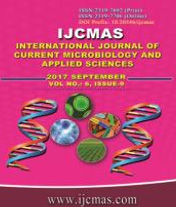


 National Academy of Agricultural Sciences (NAAS)
National Academy of Agricultural Sciences (NAAS)

|
PRINT ISSN : 2319-7692
Online ISSN : 2319-7706 Issues : 12 per year Publisher : Excellent Publishers Email : editorijcmas@gmail.com / submit@ijcmas.com Editor-in-chief: Dr.M.Prakash Index Copernicus ICV 2018: 95.39 NAAS RATING 2020: 5.38 |
Methicillin Resistant Staphylococcus aureus (MRSA) has emerged as a major community acquired and nosocomial pathogen. Antibiotic armamentarium available for the treatment of MRSA infections is limited. The increasing rate of drug resistance among the isolates demands the judicious use of the available antibiotics. Timely collection and analysis of the antibiotic susceptibility data facilitates rational implementation of empirical therapy. The present study was conducted to evaluate the prevalence and to assess the antibiotic susceptibility patterns of the MRSA isolates from our hospital. Staphylococcus aureus isolated from all clinical samples were included in the study and subjected to antibiotic susceptibility testing. Isolates of MRSA were identified and their susceptibility pattern was analysed. Of the 240 isolates of Staphylococcus aureus obtained from various samples 109 (45.42%) were found to be Methicillin resistant. 73.4% of the Methicillin resistant isolates were multi-drug resistant showing resistance to three or more antibiotics. The MRSA isolates showed 100% sensitivity to Vancomycin, Teicoplanin and Linezolid. In addition drugs like Amikacin, Nitrofurantoin, Netilmicin and Chloramphenicol were found to have good in-vitro activity against the isolates of MRSA. Antibiotic resistance among the MRSA isolates is increasing and treatment options available are few. Anti-MRSA drugs like Vancomycin, Teicoplanin, Linezolid, etc. should be used judiciously after appropriate antibiotic susceptibility testing. Regular monitoring of Antibiotic susceptibility pattern is essential to guide empirical therapy.
 |
 |
 |
 |
 |